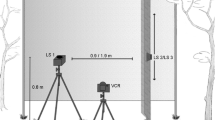Abstract
The flight tones generated by wing beat frequencies of adult female and male non-biting midges,Chironomus anthracinus, infested by a species ofLimnomermis are very similar (mean values 219.9 and 228.9 Hz respectively), intermediate between normal females (205.1) and males (363.1), but closer to that of the uninfested females. Similarly, the wing shape of parasitized individuals appears intermediate resembling the female more than the male. Statistically wing width and surface area in the parasitized adults resemble those of females and differ significantly from those of normal males. The wing length of the parasitized midges, however, is more like that of males, but there is no statistically significant difference between the groups. Malnutrition of the larvae caused by competition with the parasite seems to result in wing shortening superimposed on sexual differences. All parameters of wing shape are negatively correlated with flight tones. Weight and musculature of the parasitized individuals have also been investigated, but only where worms were present in the thorax was a change found in the flight tones. The flight tone changes served no apparent biological function for the parasitized midges, but the worms apparently benefit from behavioural changes of the infected host, thereby reaching habitats where fresh hosts for its larvae may be available.
Similar content being viewed by others
References
Beckett EB (1971) Histologic changes in mosquito flight muscle fibers associated with parasitization by filariae larvae. Parasitology 63:365–372
Brand Tv, Weinstein PO, Wright WH (1954) The working ability of rats infected withTrichinella spiralis. Am J Hyg 59:26–31
Clements AN (1963) The physiology of mosquitoes. Pergamon Press Oxford, London, New York, Paris
Dolinski ZS, Burright RG (1981) Behavioral effects of lead andToxocara canis in mice. Science 213:1142–1144
Freeland WJ (1981) Parasitism and behavioral dominance among male mice. Science 213:461–462
Götz P (1964) Der Einfluß unterschiedlicher Befallsbedingungen auf die mermithogene Intersexualität vonChironomus (Dipt.) Z Parasitenkd 24:484–545
Holmes JC, Bethel WM (1972) Modification of intermediate host behaviour by parasites. In: Canning EU, Wright CA (eds) Behavioural aspects of parasite transmission. Academic Press, London, p 123–149
Hultsch H (1975) Untersuchungen zu Verhaltensunterschieden zwischen parasitierten und nicht parasitierten Imagines vonChironomus anthracinus (Dipt., Chironomidae). Staatsexamensarbeit Univ Freiburg
Hutchinson WM, Aitken PP, Wells BWP (1980) ChronicToxoplasma infection and familiarity novelty discrimination in the mouse. Ann Trop Med Parasitol 74:145–150
Moore J (1984) Parasites that change the behavior of their host. Sci Am 250:82–89
Piekarski G, Zippelius H-M, Witting PA (1978) Auswirkungen einer latentenToxoplasmainfektion auf das Lernverhalten von weißen Laboratoriumsratten und-mäusen. Z Parasitenkd 57:1–15
Rau ME (1983a) The open field behaviour in mice infected withTrichinella spiralis. Parasitology 86:311–318
Rau ME (1983b) Establishment and maintenance of behavioural dominance in male mice infected withTrichinella spiralis Parasitology 86:319–322
Rempel JG (1940) Intersexuality in Chironomidae induced by nematode parasitism. J Exp Zool 84:261–289
Römer F (1970a) Einfluß von Temperatur und Alter auf die Flugtonhöhe beim Schwärmen vonChironomus plumosus L. Rev suisse Zool 77:603–616
Römer F (1970b) Flugtöne der Weibchen und Locktöne für Männchen vonChironomus plumosus L. beim Schwärmen. Rev suisse Zool 77:942–959
Römer F, Rosin S (1969) Untersuchungen über die Bedeutung der Flugtöne beim Schwärmen vonChironomus plumosus L. Rev suisse Zool 76:734–740
Saladin KS (1979) Behavioral parasitology and perspectives on miracidial host-finding. Z Parasitenkd 60:197–210
Sotavala O (1947) The flight-tone (wing stroke frequency) of insects. Acta Ent Fenn 4–5:1–117
Sotavala O (1952) Flight tone and wing-stroke frequency of insects and the dynamics of insect flight. Nature 170:1057–1058
Tischner H (1953) Über den Gehörsinn von Stechmücken. Acustica 3:335–343
Titmus G, Badcock (1981) A morphometric study of the effects of a mermithid parasite on its host, the Chironomid midgeEinfeldia dissidens (Walker) (Diptera). Z Parasitenkd 65:353–357
Schmidt K, Wülker W (1980) Parasitäre Intersexualität des Johnstonschen Organes in den Antennen vonChironomus (Dipt). Z Parasitenkd 64:1–15
Wülker W (1958) Parasitäre Intersexualität bei Chironomiden des Schluchsees. Gewäss Abwäss 20:61–67
Wülker W (1961) Untersuchungen über die Intersexualität der Chironomiden (Dipt.) nachParamermis-Infektion. Arch Hydrobiol Suppl 25:127–181
Wülker W (1964) Parasite-induced changes of internal and external sex characters in insects. Exp Parasitol 15:561–597
Wülker W (1978) Parasitäre Einflüsse auf undifferenzierte Gewebe. Z Parasitenkd 57:255–267
Wülker W (1983) Behavioural changes due to parasites: Flight tone and wing shape in mermithid-infested Chironomid midges (Dipt). Zbl Bakt Hyg A 256:267
Wülker W, Eisele H, Rössler R (1982) Tarsal sensilla ofChironomus (Diptera: Chironomidae): number, parasitogenic changes, ultrastructure and function. Int J Insect Morphol Embryol 11:137–146
Author information
Authors and Affiliations
Rights and permissions
About this article
Cite this article
Wülker, W. Changes in behaviour, flight tone and wing shape in nematode-infestedChironomus (Insecta, Diptera). Z. Parasitenkd. 71, 409–418 (1985). https://doi.org/10.1007/BF00928343
Accepted:
Issue Date:
DOI: https://doi.org/10.1007/BF00928343




